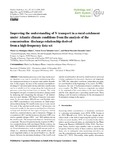Mostrar el registro sencillo del ítem
Improving the Understanding of N Transport in a Rural Catchment Under Atlantic Climate Conditions From the Analysis of the Concentration–Discharge Relationship Derived From a High-Frequency Data Set
| dc.contributor.author | Rodríguez-Blanco, María-Luz | |
| dc.contributor.author | Taboada-Castro, M. T. | |
| dc.contributor.author | Taboada-Castro, María Mercedes | |
| dc.date.accessioned | 2023-06-27T18:38:58Z | |
| dc.date.available | 2023-06-27T18:38:58Z | |
| dc.date.issued | 2023-03-21 | |
| dc.identifier.citation | Rodríguez-Blanco, M. L., Taboada-Castro, M. T., and Taboada-Castro, M. M.(2023). Improving the understanding of N transport in a rural catchment under Atlantic climate conditions from the analysis of the concentration–discharge relationship derived from a high-frequency data set, Hydrol. Earth Syst. Sci., 27, 1243–1259, https://doi.org/10.5194/hess-27-1243-2023 | es_ES |
| dc.identifier.issn | 1607-7938 | |
| dc.identifier.uri | http://hdl.handle.net/2183/33256 | |
| dc.description.abstract | [Abstract] Understanding processes controlling stream nutrient dynamics over time is crucial for implementing effective management strategies to prevent water quality degradation. In this respect, the study of the nutrient concentration–discharge (C–Q) relationship during individual runoff events can be a valuable tool for extrapolating the hydrochemical processes controlling nutrient fluxes in streams. This study investigated nitrogen concentration dynamics during events by analyzing and interpreting the nitrogen C–Q relationship in a small Atlantic (NW Iberian Peninsula) rural catchment. To this end, nitrate (NO3-N) and total Kjeldahl nitrogen (TKN) concentrations were monitored at a high temporal resolution during 102 runoff events over a 6-year period. For each of the selected runoff events, C–Q response was examined visually for the presence and direction of hysteresis loops and classified into three types of responses, namely clockwise, counterclockwise, and no hysteresis. Changes in concentration (ΔC) and the hysteresis direction (ΔR) were used to quantify nitrogen ( and TKN) patterns during the runoff events. The transport mechanisms varied between compounds. The most frequent hysteretic response for was counterclockwise with enrichment. On the contrary, the main TKN dynamic was enrichment with clockwise hysteresis. Event characteristics, such as rainfall amount, peak discharge (i.e., maximum discharge of the runoff event), and event magnitude relative to the initial baseflow (i.e., the difference between the maximum discharge of the runoff event and the initial baseflow divided by initial baseflow) provided a better explanation for hysteresis direction and magnitude for TKN than antecedent conditions (antecedent precipitation and baseflow at the beginning of the event). For hysteresis, the role of hydrometeorological conditions was more complex. The hysteresis magnitude was related to the magnitude of the event relative to the initial baseflow and the time elapsed since a preceding runoff event. These findings could be used as a reference for the development of N mitigation strategy in the region. | es_ES |
| dc.description.sponsorship | This research has been supported by the Spanish Ministry of Education and Science (grant no. REN2003-08143) and Xunta of Galicia (grant nos. PGIDIT05RAG10303PR and 10MDS103031PR) | es_ES |
| dc.description.sponsorship | Xunta of Galicia; PGIDIT05RAG10303PR | es_ES |
| dc.description.sponsorship | Xunta of Galicia; 10MDS103031PR | es_ES |
| dc.language.iso | eng | es_ES |
| dc.publisher | European Geosciences Union | es_ES |
| dc.relation | info:eu-repo/grantAgreement/MEC/Plan Nacional de I+D+i 2000-2003/REN2003-08143/ES/ | es_ES |
| dc.relation.uri | https://doi.org/10.5194/hess-27-1243-2023 | es_ES |
| dc.rights | Atribución 4.0 Internacional | es_ES |
| dc.rights.uri | http://creativecommons.org/licenses/by/4.0/ | * |
| dc.subject | Water quality | es_ES |
| dc.subject | Nitrogen | es_ES |
| dc.subject | Catchment hydrology | es_ES |
| dc.subject | Instruments and observation techniques | es_ES |
| dc.subject | Atlantic climate | es_ES |
| dc.title | Improving the Understanding of N Transport in a Rural Catchment Under Atlantic Climate Conditions From the Analysis of the Concentration–Discharge Relationship Derived From a High-Frequency Data Set | es_ES |
| dc.type | info:eu-repo/semantics/article | es_ES |
| dc.rights.access | info:eu-repo/semantics/openAccess | es_ES |
| UDC.journalTitle | Hydrology and Earth System Sciences | es_ES |
| UDC.volume | 27 (2023) | es_ES |
| UDC.startPage | 1243 | es_ES |
| UDC.endPage | 1259 | es_ES |
| dc.identifier.doi | 10.5194/hess-27-1243-2023 |
Ficheros en el ítem
Este ítem aparece en la(s) siguiente(s) colección(ones)
-
GI-GRICA - Artigos [49]






